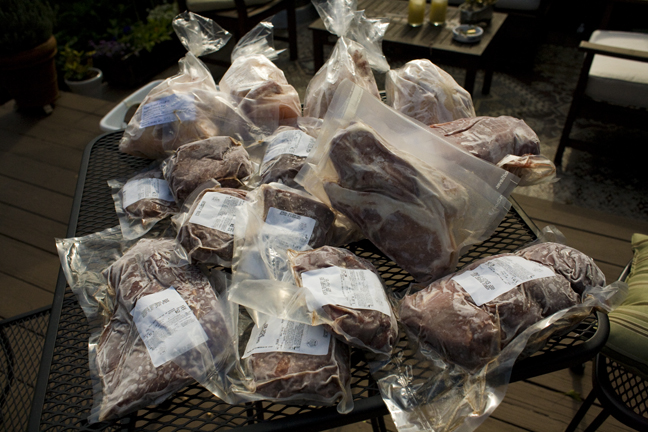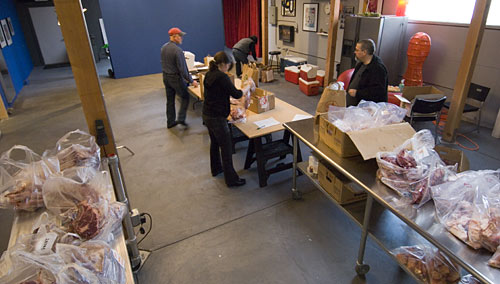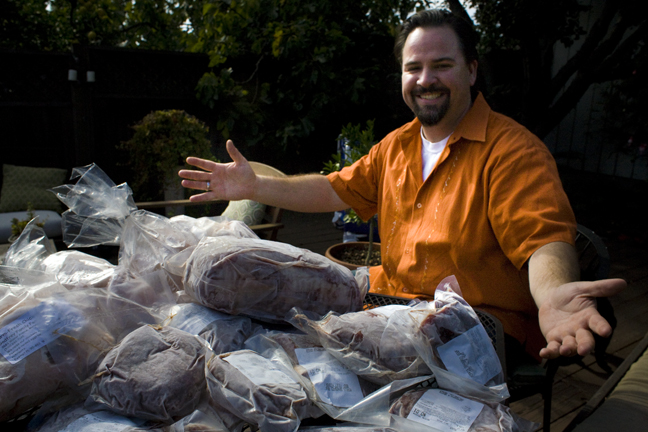The deal went down by the Berkeley Marina. Matt Markovich handed over several hundred dollars to a man in a van and drove away 70 pounds heavier.
“It was like Miami Vice contraband,” Markovich, 36, said recently while sitting at the dining room table in his cozy Oakland home.
The packages were already split into tidy parcels and vacuum packed. Once home, he made a few calls, and waited for other buyers to arrive so he could hand out the goods.
He wasn’t buying drugs. No, Markovich was in the market for something different. He and some friends had teamed up to buy half a cow direct from a rancher, Morris Grassfed Beef in San Juan Bautista.
This type of meat-sharing arrangement is gaining ground in the San Francisco Bay Area as people have become more concerned with where their food comes from and how it is raised.
“You’re keeping money in the community, supporting small farmers and having a reduced environmental impact because your food doesn’t get trucked as far,” Markovich said. “You’re helping support the entire ecosystem. People talk about eating within a 100-mile radius of their homes. We can do that here. From field to fork, I know exactly what is going on with the food I’m eating.”
Markovich made his first bulk meat buy with friends. But six months ago, he stumbled onto a Web site for like-minded consumers, the Bay Area Meat CSA (Tagline: “Buy good, healthy meat directly from local ranchers”).
He’s since used the site to purchase beef, pork, chicken and eggs. The site helps people band together to purchase animals, and gives ranchers a way to connect with their target audience. It has more than 700 members who live in Oakland, Berkeley and throughout the Bay Area.
Supporters say this approach to eating meat is full of valuable lessons. It offers a crash course in how to cook all parts of an animal, not just steaks and ground meat. It exposes people to heritage breeds, special varieties with distinctive flavors and qualities. And it adjusts their sense of what’s sustainable; when the few slices of bacon that come in a pig share are gone, for example, there’s no more bacon until you buy the next hog.
“I love tri-tip but there’s only one on the cow,” said small farmer Rose Godfrey of Marysville, who uses the CSA’s Web site to reach customers. “If I want to go down and buy 20 pieces of tri-tip for a party, that’s 20 cows. And then where did the rest of it go? It’s much better for us, and for the environment, to use it all up and be thoughtful in how we eat.”
Community Supported Meat
CSA stands for “Community Supported Agriculture,” and refers to a system where people buy direct from farms, often in the form of weekly boxes. Subscribers pay by the month or the season, which gives farmers a sense in advance about how much to produce. Boxes of vegetables have become increasingly common, and other offerings, including grains, fish and berries, have sprung up around the country as small farmers look for more ways to reach people who make eating local a priority.
LocalHarvest.org, an online directory of CSAs, lists more than 2,500 of them around the United States. Plug in an Oakland zip code, and you’ll find 22 different CSAs to choose from. (The government does not track how many CSAs have been formed in the U.S. But, according to Tim Galarneau, who studies food systems in the Center for Agroecology & Sustainable Food Systems at UC-Santa Cruz, the feds are on track to begin funding research in the next few years on these “new generation buying clubs.”)

The Bay Area Meat CSA, which is free to join, has an extensive directory for members that includes several farms offering meat boxes by subscription. Most of the sales, however, take on another form, as ranchers post to the message board about animals available for harvest, or members seek partners for bulk meat purchases.
Reading the message titles on the group’s home page, it’s easy to imagine vendors hawking their wares in a rowdy marketplace. Step right up and get your “Naturally Raised Heritage Pork,” “Fresh Heritage Breed TURKEYS,” “Pastured Pork and Pastured Veal.” Other offerings include lamb, chicken and, of course, beef. Group members can see what’s available, then arrange to buy individually or with others.
Easier said than done. Making the purchase and dividing up the meat can be a challenge. It’s well worth it, say members of the group, but none of them sugarcoat the obstacles.
It's a lot different from the online shopping most of us do: Imagine you’re looking for a toaster. Go to your favorite Web shopping site. Search “toaster.” Sort by price. Look at a few reviews, add it to your cart, pay with your credit card and a few days later it arrives at your doorstep.
Not so with meat. “You will pay more and you may be extremely inconvenienced. It’s not for people who are looking for a bargain,” said Bonnie Powell, 37, the somewhat accidental founder of the Bay Area Meat CSA.
In 2006, Powell was transitioning from being vegetarian, and looking for a place to find quality meat, when she came upon the idea of buying direct in bulk. As she learned more about the options, and teamed up with Tamar Adler to streamline the process, a community developed. The group started out as a traditional subscription service where members signed up for baskets; it is now more like a social network, run by Slow Food Berkeley, that helps people organize their own purchases.
“Meat CSAs are a lot more complicated than vegetable CSAs,” she said. Powell, a writer and editor in Oakland who created Ethicurean.com, now runs two meat CSAs that offer box subscriptions: Soul Food Farms, which has room for more members, and Clark Summit Farm, which has a 300-person waiting list. “Carrots are carrots. No one minds if you swap cucumbers for carrots one week.”
But give someone ground beef instead of tri-tip and, watch out – there may be hell to pay. When buying in bulk, customers don’t get to cherry pick their orders. Purchase a share of beef, and you’ll get a range of cuts – primes, roasts and braises; for the more adventurous, organs, tongues and other goodies are available. Purchase a pig, and it’s not going to be all bacon.

One reason the Bay Area meat sharing group shifted from subscriptions to do-it-yourself was because of the challenge of dividing up something as complex as an animal among dozens of people with very specific desires.
“People were complaining about random things,” said Brenda Ng, a researcher in San Francisco. “They want a roast, a huge roast, a prime rib roast. Or they want some kind of French pork chop wrap. Or they don’t want ground meat because they don’t eat it. What people need to understand is that, if someone gets a New York strip roast, no one else can get that cut. People are used to going to the store and getting exactly what they want. Okay, we’re not a supermarket.”
Ng, 34, was a member of the original meat sharing group when Tamar Adler arranged baskets for subscribers. Ng now organizes large purchases through the meat sharing Web site. It’s been a learning process, she said. She once ended up with 15 extra chicken carcasses when people who had signed up for them never arrived to take them home. Remember the description above for buying a toaster? Forget about it. Here’s how Ng remembers her first bulk purchase:
“I was like, I want to get a pig from Brock Fulmer from Black Sheep Farm. I called Brock up. You have to get some information from the farmer – what they have to offer, the cost per pound, etc. – then you have to tell people what you learned and see how many people are interested. Then you have to go back to the farmer and say, ‘I think I can put an order in now.’ He can’t even tell you when he can give you the animal. Then you worry that, three months down the road, the other members will have completely forgotten buying 20 pounds of meat. It’s actually kind of miraculous that it works out.”
Ng said most people do remember. Which is a good thing when she has to put the whole purchase price, hundreds or even thousands of dollars, on her credit card, then rely on getting paid back by other meat sharers on pick-up day.
Before the pick-up, the organizer works with the rancher and butcher to figure out how many cuts to make of each part of the animal. There’s a spreadsheet on the Bay Area meat sharing Web site that lays out how to divide a cow. For other animals, it’s a bit more freeform.
How to Share Meat
It’s daunting, but there are ways to ease into the process, Ng said. Start with chickens – you get them whole. There’s no dividing to worry about. Move on to lamb or veal, animals that can be split two or four ways, to get the hang of it. Save the pigs and cows until you’re ready for a challenge.
Some worry that they won’t have room to store all that meat. A single share of beef, about 20 pounds, fits into a quarter of the freezer, Ng said. That portion will contain, at most, two pounds of steak, like filet mignon; 10 pounds of ground meat; four pounds of a slightly tougher cut, such as tri-tip or flank; and some sort of braising meat, like brisket.
Ng said she likes the system because of the high quality of the meat and because she gets to interact with farmers directly.
“They tell you about their animals, how proud they are, how they feed them, how to cook them. I like that connection to people,” she said. “I like the idea I’m supporting somebody I know personally as opposed to shopping at Wal-Mart.”
One of the farmers she’s gotten to know is Mel Thompson, 62, who raises sheep with his wife, Mary, 59, at Sierra Farms in Oroville. Thompson, a life-long rancher, has been using the Bay Area meat sharing Web site for about a year and a half, and said it’s been a boon for business. He said, from what he’s seen, urban dwellers seem to be more and more interested in farming.
“It’s part of a yearning for a different way of life,” he said. “The food is just sort of the metaphor. People complain about kids playing video games, but what else is there? If they knew a farmer, we could say, ‘Come out to the ranch a couple times a year.’ Only three percent of the population is in farming and ranching – it seems to me that’s way out of balance. The other 97 percent are wishing they could ride a horse. A lot of them want to know where their food is coming from.”
Time, Patience, Community, Meat
 Thompson and other farmers who sell through the Bay Area Meat CSA were invited or approved by Tamar Adler (pictured left with Brock Fulmer), the writer and former Chez Panisse chef who worked with Bonnie Powell to turn the CSA into a self-sustaining model. Adler, 32, still oversees the site but recently moved back to New York, her home state.
Thompson and other farmers who sell through the Bay Area Meat CSA were invited or approved by Tamar Adler (pictured left with Brock Fulmer), the writer and former Chez Panisse chef who worked with Bonnie Powell to turn the CSA into a self-sustaining model. Adler, 32, still oversees the site but recently moved back to New York, her home state.
Adler said she vets every rancher in the CSA’s directory to make sure his or her practices are sustainable and that all the meat is “good, clean and fair.” It’s not all organic, but cows must spend most of their lives on pasture. And the farmers emphasize the high quality of life the animals lead.
“Our animals are raised outside, on pasture, never on concrete, never in crates. They frolic about, lie in the sun, and enjoy life. We like to say they only have one bad day,” writes Rose Godfrey’s on her blog about Godfrey Family Farms, which sells meat on the meat sharing site. (Godfrey’s farm is putting together a meat CSA that may still have a few spots left. Subscribers can look forward to chickens, eggs and pork, ducks, rabbits, guinea fowl, “and Turkeys at Thanksgiving.”)
But all that high living comes with a pretty big wallop to the wallet. Six dollars for a dozen eggs. Seven dollars a pound for pork or lamb, $6 a pound for beef. If you’re buying a 20-pound share of beef, that’s $120 right up front. For people who are used to shopping at the farmer’s market, meat sharing may offer a better, or at least comparable, deal. Probably not so easy for lower-income families.
Some Oakland organizations, such as People’s Grocery, subsidize weekly vegetable boxes for people living in “food deserts,” where access to fresh food is limited. There doesn’t seem to be anything similar for meat shares. Powell said people who participate in meat shares are doing more than just voting with their pocket books. Meat CSAs, Powell said, are a bigger commitment, whether you sign up for a basket or divide up a cow.
“If you were just voting with your pocket book, you would only go to the farmer’s market,” Powell said. “When you join a meat CSA, you’re also voting with your time, your patience and a sense of community spirit.”
Some meat CSA members said they eat less meat to compensate for higher costs. But, even if you cut back, it can still be a big investment.
Berkeley writer and activist Fred Dodsworth said the only real way to make this kind of eating more affordable is by growing it yourself – plant a garden, raise some chickens. Urban farming is becoming increasingly popular; Oaklander Novella Carpenter’s Ghost Town Farm is one exciting example. But it’s still a long way from mainstream.
“You can’t manage costs. This is not about costs,” Dodsworth said. “If you’re in this because you want to save money, go back to buying hamburger at Safeway on sale. This is about eating stuff that’s good for you. This is about eating good quality food that feeds your soul and feeds your community. It’s about an emotional commitment to a style of life.”
Photos courtesy of Bonnie Powell.
###
This article originally appeared in Oakland Local, an independent, non-profit community news and information hub, connecting community and news.









